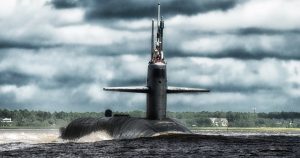In Short: Hopefully routine.
Read on Medium
Read Time: 3 minutes
Comments
Modern day nuclear submarines spend most of their time deeper than 150 feet (measured surface to keel) while in transit from one place to another, searching for enemy subs or on patrol, working to remaining undetected. However, they do need to come to periscope depth several times a day to copy radio messages and connect to GPS to update their positions.
A submarine at periscope depth is in its most vulnerable condition, especially when in areas with high shipping density, because there is always a chance of a high-speed contact closing without being seen by the periscope watch or without being detected on sonar. Such a situation could result in a collision between the submarine and a surface ship, or detection of the submarine by unfriendly forces.
Given that some of the world’s largest ships have drafts up to 80 feet, 150 feet is as shallow as they can routinely go and still be reasonably certain not to be run down by one of those large ships. Therefore, minimizing the time between 150 feet and periscope depth (keel depth 58–62 feet, depending on sub configuration, sea state, and tactical situation) is highly desirable.

To reduce visibility of a periscope’s wake, ship speed is set at sea state plus two knots. Since sea state in the open ocean is seldom less than 3, most approaches to periscope depth are made at 5 knots, with speed being adjusted once at periscope depth (P/D) based on visual observation of the wake being produced. This can be a problem on dark nights, so knowing the sea state during the previous excursion is important.
Normally when coming to periscope depth P/D from 150 feet, the Officer of the Deck circles continuously on the #2 periscope with its elevation trained fully up until he sees the surface of the water, usually at a few feet below the surface. As the sub continues up, he lowers the elevation of the periscope optics to be looking across the surface of the ocean as the periscope breaks the surface. At that point he announces, “Scope’s clear,” and after another turn or two, hopefully, “No close contacts.”
If there is something close, he yells, “Emergency Deep!” — which triggers actions intended to get the sub to a safe depth quickly. Only after one of those two statements are issued does the Ship Control Party resume their normal duties. Until then, all ship control watchstanders are on high alert, and the control room is silent while awaiting one of those reports.
As the OOD on a morning watch during routine operations in the Mediterranean Sea, I was bringing the ship to P/D in very calm water. The water was so smooth that as the periscope head window was a few feet below the surface, I caught a glimpse of a black oval object forward of the ship. I was about to yell, “Emergency Deep!” when I realized that I was seeing a reflection of the forward emergency rescue buoy off the smooth ocean surface.
Fortunately, the few milliseconds it took me to form the words “Emergency Deep!” prevented what might have been a slightly embarrassing discussion with the Captain.
—
John Bickford served on five different attack submarines during his 20-year Navy career, including Command Officer in the late 1980s. He is now retired and living in Kennewick, Wash., and volunteers at a restored Carousel.
To Tell Your Own WiLt story, see the Submission Guidelines.

I find stuff like this interesting. Thanks for the story.
Very interesting. Learn something new every day
Fascinating! Thanks for sharing.
Thanks for sharing interesting information!
After reading this i have lots of questions and wish i could have included a dive in my life experiences. However! What are the instruments by which sea state is determined? How are the variables of surface storm, current, and depth constantly adjusted for? You were in the Mediterranean which in my memory of its eastern coast surface is less hazardous than the Atlantic coast off Gibraltar, but is that a lay person’s view and not accurate? Finally, could you please write some more WILT stories on this for Randy to publish and maybe, eventually, do an e-book?
—
While I think it would be great if John answered your questions here, a “lot” of stories about submarine dives/surfacing wouldn’t be in the cards: I’m looking for variety more than depth (no pun intended). That said I like everyone’s stories so far, and it IS fine for the authors to submit more than one: we all have a lot of interesting experiences! 🙂 -rc